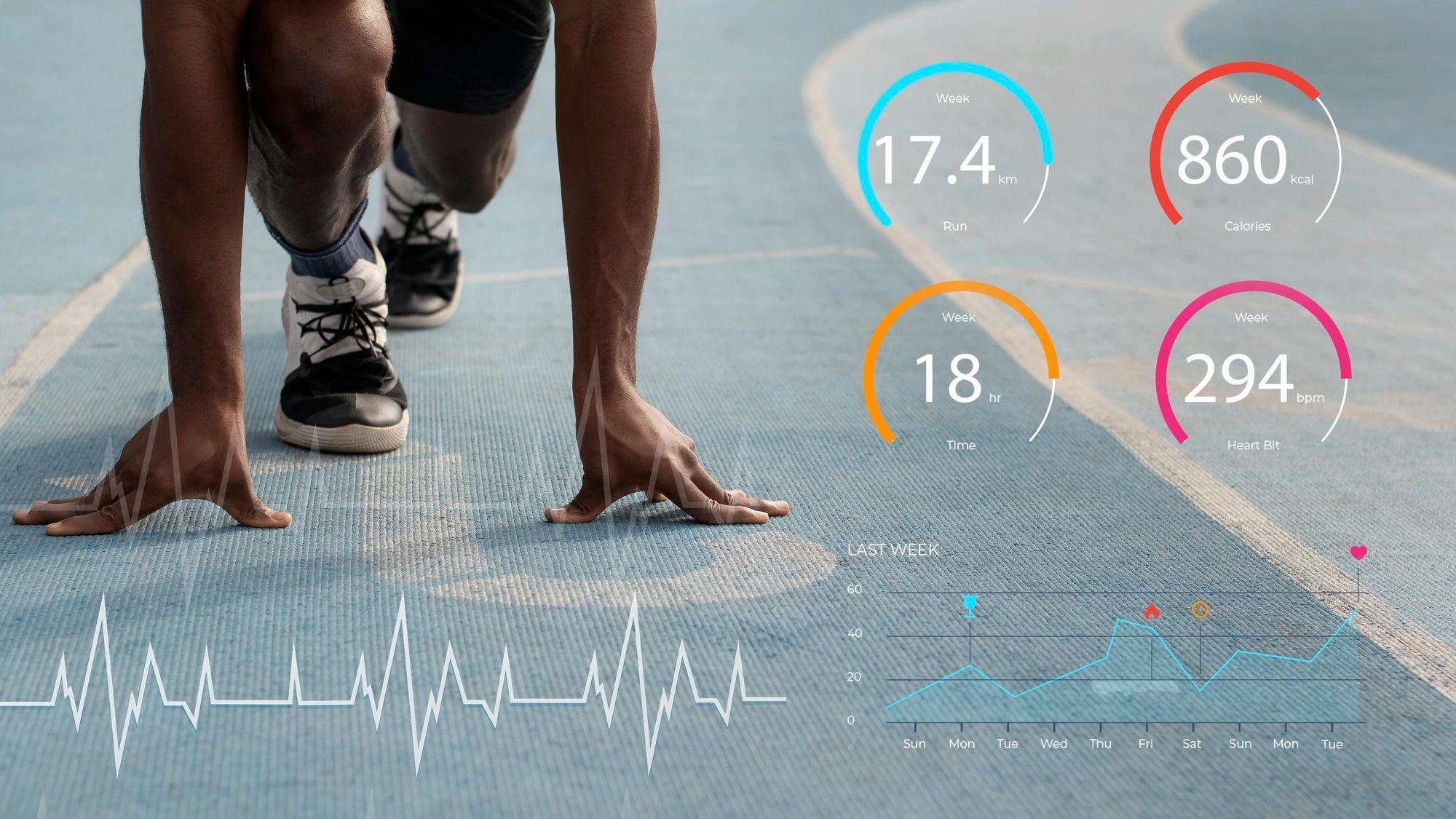Running is one of the most effective cardiovascular exercises, but maximizing its benefits requires more than just effort—it demands strategy. One of the most reliable ways to optimize performance, prevent injuries, and enhance endurance is by monitoring your running heart rate.
Heart rate reflects how hard your heart is working during exercise, influenced by factors like fitness level, hydration, sleep, and environmental conditions. By tracking heart rate and training within specific heart rate zones, runners can improve efficiency, endurance, and recovery.
This article explores the science behind heart rate monitoring, explains how to calculate and apply heart rate zones, and provides research-backed strategies for improving running performance.
In This Article
Why Heart Rate Matters for Runners
Heart rate is a direct measure of cardiovascular effort. According to the American College of Sports Medicine (ACSM), heart rate training can help runners balance effort and recovery, improving overall efficiency (Thompson et al., 2010).
Key Benefits of Heart Rate Monitoring
- Improved Training Efficiency – Helps runners train at the right intensity.
- Enhanced Recovery – Avoids overtraining by monitoring heart rate trends.
- Reduced Risk of Injury – Prevents excessive strain on the heart and muscles.
- Personalized Training Plans – Adjusts training intensity based on fitness levels.
A study published in the Journal of Strength and Conditioning Research found that heart rate monitoring significantly improved endurance training outcomes by ensuring optimal exertion levels (Seiler, 2010).
Factors That Influence Running Heart Rate
1. Age and Fitness Level
Heart rate naturally decreases with age due to physiological changes (Tanaka et al., 2001). Additionally, trained runners typically have lower resting heart rates (RHR) due to enhanced cardiac efficiency.
2. Hydration and Nutrition
Dehydration increases heart rate and perceived effort. Research published in Sports Medicine suggests that a 2% loss in body weight from dehydration can elevate heart rate by 3–5 BPM (Sawka et al., 2017).
3. Environmental Conditions
Studies in the European Journal of Applied Physiology show that heat and humidity increase cardiovascular strain, causing higher heart rates at a given intensity (Cheung & McLellan, 1998).
| Environmental Factor | Effect on Heart Rate |
|---|---|
| Heat & Humidity | Increases HR due to thermoregulation |
| Altitude | Increases HR due to lower oxygen levels |
| Cold Temperatures | May lower HR at steady-state efforts |
4. Sleep and Stress
Sleep deprivation and chronic stress elevate cortisol levels, increasing resting and exercising heart rate (JAMA Internal Medicine, Steptoe & Kivimäki, 2012).
5. Caffeine and Stimulants
Caffeine can increase heart rate by 3-10 BPM, depending on sensitivity (Grgic et al., 2020, Journal of the International Society of Sports Nutrition).
How to Calculate Your Maximum Heart Rate (MHR)
MHR is the highest number of beats per minute your heart can reach during exercise. While lab-based VO₂ max tests are most accurate, predictive formulas offer reasonable estimates.
Common MHR Formulas
| Formula | Calculation | Best Use Case |
|---|---|---|
| Fox Formula | 220 – Age | General estimation |
| Tanaka Formula | 208 – (0.7 × Age) | More accurate for adults (Tanaka et al., 2001) |
| Gulati Formula | 206 – (0.88 × Age) | Designed for women (Gulati et al., 2010) |
For a 33-year-old runner:
- Fox: 220 – 33 = 187 BPM
- Tanaka: 208 – (0.7 × 33) = 185 BPM
- Gulati (for women): 206 – (0.88 × 33) = 177 BPM
A study in Medicine & Science in Sports & Exercise confirms the Tanaka formula is more accurate for adults (Tanaka et al., 2001).

Understanding Heart Rate Zones for Training
Training within heart rate zones ensures runners target the right physiological adaptations.
| Heart Rate Zone | % of MHR | Training Purpose |
|---|---|---|
| Zone 1 (Very Light) | 50-60% | Active recovery, warm-ups |
| Zone 2 (Light) | 60-70% | Aerobic base building, fat burning |
| Zone 3 (Moderate) | 70-80% | Tempo runs, endurance |
| Zone 4 (Hard) | 80-90% | Lactate threshold training |
| Zone 5 (Maximum) | 90-95% | Sprinting, anaerobic capacity |
Training Balance: The 80/20 Rule
Research from Frontiers in Physiology suggests that 80% of runs should be in Zones 1-2, with 20% in high-intensity zones for optimal endurance development (Seiler, 2010).
Optimizing Your Running Heart Rate
1. Monitor and Adjust Training Intensity
A sudden spike in heart rate at a steady pace may indicate dehydration, fatigue, or overtraining.
2. Prioritize Hydration and Electrolytes
- Drink 500 mL (16 oz) of water 2 hours before running.
- Use electrolyte replacements for long runs, especially in hot conditions (Sports Medicine, Sawka et al., 2017).
3. Improve Sleep and Recovery
Track resting heart rate (RHR) in the morning. An increase of 5+ BPM over baseline may indicate insufficient recovery.
4. Use Wearable Technology
Devices like chest straps and optical sensors offer accurate heart rate tracking. A study in JMIR mHealth found that chest straps (e.g., Polar H10, Garmin HRM-Pro) are more accurate than wrist-based monitors (Gillinov et al., 2017).
5. Gradually Adapt to Heat and Altitude
Heat adaptation takes 7–14 days, while altitude training may require 2+ weeks (Chapman et al., 2014, Scandinavian Journal of Medicine & Science in Sports).
Conclusion
Optimizing your running heart rate can lead to better performance, endurance, and recovery. By training within heart rate zones, staying hydrated, monitoring stress, and utilizing wearables, runners can train smarter and reduce injury risk.
With research-backed strategies, heart rate monitoring becomes a powerful tool for sustainable running success.
References
- Cheung, S. S., & McLellan, T. M. (1998). Heat acclimation, aerobic fitness, and hydration effects on tolerance during uncompensable heat stress. European Journal of Applied Physiology, 78(1), 50-58.
- Gillinov, S., et al. (2017). Variable accuracy of wearable heart rate monitors during aerobic exercise. JMIR mHealth and uHealth, 5(2), e34.
- Grgic, J., et al. (2020). Caffeine ingestion enhances muscular endurance: A meta-analysis. Journal of the International Society of Sports Nutrition, 17(1), 1-10.
- Gulati, M., et al. (2010). Heart rate response to exercise stress testing in asymptomatic women. Circulation, 122(2), 130-137.
- Sawka, M. N., et al. (2017). Exercise and fluid replacement. Sports Medicine, 47(Suppl 1), 51-60.
- Seiler, S. (2010). What is best practice for training intensity and duration distribution in endurance athletes? Frontiers in Physiology, 1, 33.
- Steptoe, A., & Kivimäki, M. (2012). Stress and cardiovascular disease. JAMA Internal Medicine, 172(10), 749-757.
- Tanaka, H., et al. (2001). Age-predicted maximal heart rate revisited. Journal of the American College of Cardiology, 37(1), 153-156.










0 Comments